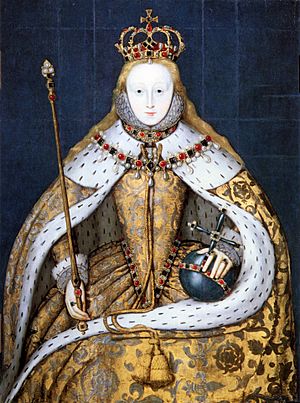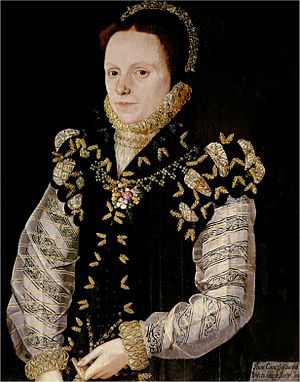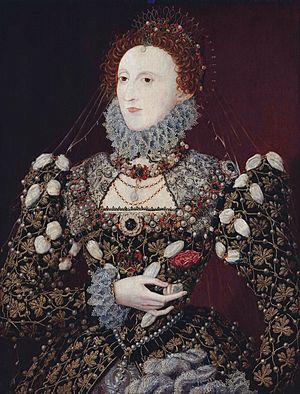Walter Fyshe facts for kids

Walter Fyshe was a skilled tailor in London who lived during the time of Elizabeth I. He worked for the Queen until 1582, making many of her beautiful clothes. He even created some of her farthingales, which were special hoop skirts that made dresses look wide and grand. Walter Fyshe was also responsible for making the Queen's fancy ceremonial outfits and her important coronation robes. He even changed robes that had been made for Queen Mary I of England so Elizabeth could wear them.
Walter Fyshe's Work for the Queen
Walter Fyshe is mentioned in the royal records from 1557. He was a member of a group called the Worshipful Company of Merchant Taylors, which was a guild for tailors. Sometimes, people would ask Fyshe to help settle arguments about tailor's bills. For example, in 1566, he checked the bills of a tailor named Molde, who had made clothes for Anne, the wife of Henry Mewtas. Records show that Fyshe lived in a place called Budge Row.
Queen Elizabeth was very interested in the latest fashions from other countries in Europe. Some of her clothes were designed using special patterns called "toiles." These patterns were sometimes sent to France to be finished. Other times, clothes were partly made in France and then Walter Fyshe would complete them in England. In 1567, the Queen asked her ambassador, Henry Norris, to find a tailor in Paris who could make clothes in the Italian and French styles. Even though Norris's wife, Margery Williams (whom Elizabeth called "Crow"), tried to help, they couldn't find anyone. Some historians believe that a gown Elizabeth wears in a famous painting called the 'Phoenix' portrait might have been a pattern sent from France and then made by Fyshe.
After 1567, a different tailor named John Bate became the specialist for making Elizabeth's farthingales. However, Walter Fyshe still made other items for the Queen. For example, in 1577, he made a cloak and a "safeguard" (a type of protective outer skirt) for Bess of Hardwick to give to the Queen as a New Year's Day gift.
In 1574, Walter Fyshe was given a special role as a "yeoman" for the Master of the Revels. The Revels office was in charge of royal entertainment, like plays and masques. Fyshe helped create costumes for musicians and actors. For a special show at Richmond Palace in January 1579, he made costumes for actors dressed as Amazons. These Amazons and knights would arrive at the palace, dance with the audience, and even put on a fight! Fyshe also bought coal to keep the stored Revels costumes dry and fresh. He often signed the Revels accounts as "Walter Fysshe."
Walter Fyshe stopped working in 1582 and passed away in 1585. Many records show how much work he did for the English court. In his will, he left a gold ring to an embroiderer named Davy Smith. Walter Fyshe married Elizabeth Worthington in 1547, and she lived longer than him.
Making Clothes for Royal Courtiers

Walter Fyshe and his team also made clothes for other important people at Queen Elizabeth's court. This included her maids of honour, ladies of the privy chamber, and other attendants. For example, in 1565, he made six beautiful gowns for the maids of honour to wear at a wedding. These gowns were made of yellow satin with green velvet edges and silver lace. The wedding was for Anne Russell, who was the daughter of the Earl of Bedford. She married Ambrose, Earl of Warwick, on November 11, 1565. The maids who wore these gowns included Mary Howarde, Anne Windesoure, Katherine Bridges, Katherin Knevit, Mary Ratlyf, and Dorothy Broke.
In 1572, Queen Elizabeth gave eleven gowns as gifts to some of her ladies. These gowns were made of crimson velvet, blue taffeta, and a reddish-brown satin called "murrey." They were decorated with sky blue and white lace. The ladies who received these gifts included Lady Susan Bowser, Mary Ratclyff, Eleaner Bridges, Elizabeth Garrett, Katheryn Howarde, Ysabell Holcrofte, Fraunces Howarde, Elizabeth Knolles, Anne Weste, Elizabeth Stafforde, and Mary Shelton.
Sometimes, women received new clothes from the Queen when they got married. In 1567, Dorothy Broadbelt, who was a gentlewoman in the Queen's chamber, received a black velvet gown from Flanders. It was made by Fyshe when she married John Abington, who worked in the royal kitchen.
Walter Fyshe and the Royal Wardrobes
George Brediman was in charge of the Queen's Wardrobe of Robes. This was where all the royal clothes were kept. Many official documents, called royal warrants, were sent to Brediman. These documents often mentioned the wardrobe at Whitehall or Westminster, which were actually the same place at that time. Brediman would give out fabrics for royal entertainment (revels), to Kat Ashley for the Queen's own use, and also to Walter Fyshe for his tailoring work.


